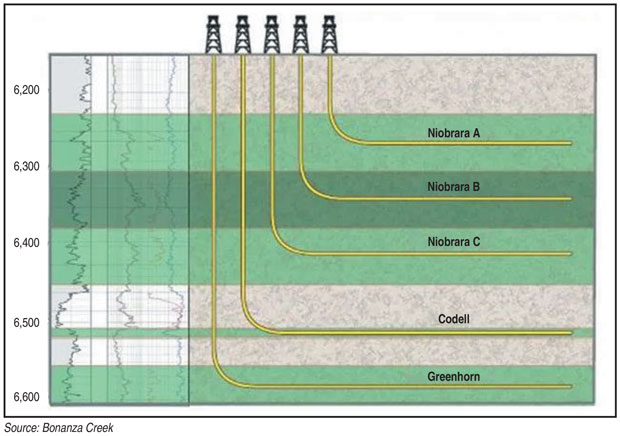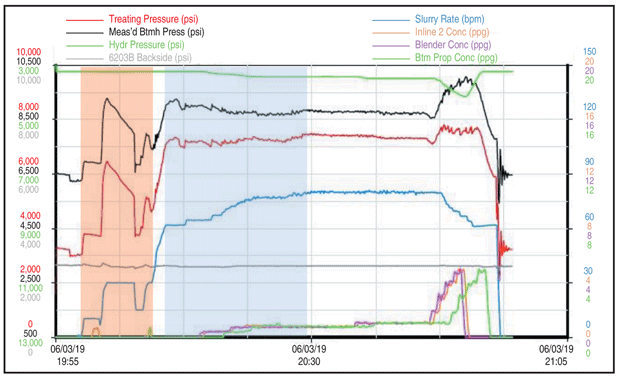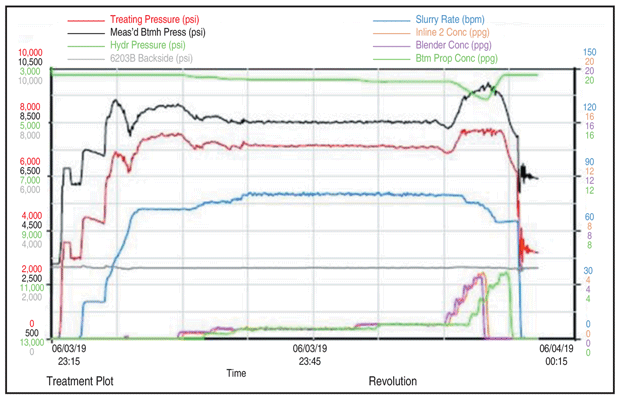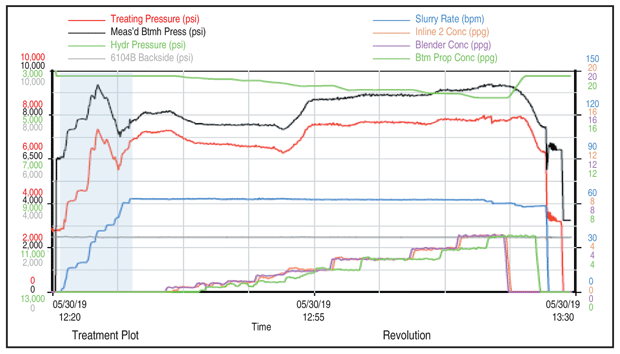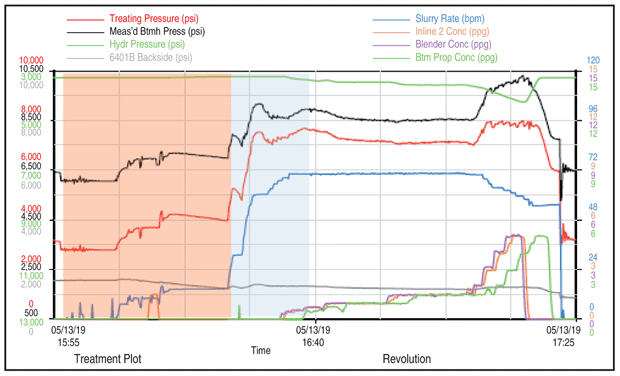
Wireline-Deployed Acid Improves Frac Efficiency, Reduces Costs In Niobrara
By Matt Schwartz, Kye Yocham and Daniel Allison
DENVER–In the multiple-bench Niobrara play in the Denver-Julesburg Basin, horizontal plug-and-perf operations typically pump down the plug and guns through wireline and a pump down unit with freshwater or produced water. Once the plug has been set and the perforating guns have been discharged, wireline pulls out of the hole, the well is swapped to the frac spread and fracturing operations start pumping down the ball.
In these operations, it is common to pump 7.5%-15.0% hydrochloric acid immediately after dropping the ball to clean up near-wellbore damage associated with the perf charges and dissolve any acid-soluble material in the formation. The pumping rate generally is held steady at a low rate until the ball is seated on the plug and acid hits the perforations. At the moment acid hits the perforations, pressure typically plunges, allowing the designed frac pump rate to be achieved.
However, recent developments in plug design, materials and components have been introduced that can help improve overall efficiencies. Among these new developments are ball-in-place or ball-in-cage plug designs that allow for zonal isolation to be completed in one step. This is significant because it saves time and fluid by eliminating the unnecessary overflushing of fluid into the previously completed zone. Moreover, if acid still is required to help with breakdown pressures for fracture initiation, the water and time savings provided by the ball-in-place plug cannot be fully appreciated because of the subsequent overflush required to displace acid into the perforations.
D-J Basin Field Trial
A field trial was executed on a four-well pad using a modified hydrochloric acid replacement (HCR) system and ball-in-place plug to determine if operational efficiencies could be achieved by spotting the HCR with wireline and bottom-hole assembly in the hole and perforating through the HCR, instead of using traditional spearhead methods and HCl. The results show that the total pump time to reach the designed frac rate and the total stage pump time both decreased, while the average pad rate per well increased. These findings are significant in that there was a noteworthy amount of time and operational efficiencies observed by spotting HCR with the wireline and BHA in the hole.
Depending on the formation, pump down rate, and wellbore volume, typical pump down times for HCl can range between 10-20 minutes. This novel method of spotting a HCR blend with wireline essentially eliminates the time to displace acid, saving an average of 6-20 minutes per stage on a typical horizontal well in the D-J Basin.
Using this approach to deploy acid during wireline plug-and-perf operations, operators can achieve greater efficiency and reduce cycle time and capital expense while accelerating production due to faster completion schedules.
The liquids-rich DJ Basin in Northeast Colorado and Southeast Wyoming is composed of various sandstone, chalk, marl, and shale formations. The target in this study focuses on the Niobrara formation, which is composed of three separate benches: the A, B and C (Figure 1).
The field trial consisted of utilizing a ball-in-place plug and simultaneously spotting HCR with the wireline and BHA still in the hole. This method allows for an operator to pump the tools down with the spearhead acid to perforate the zone in or near the acid, and let the acid sit over the perforations or have the acid in place next to the perforations. This approach saves substantial time and water in each stage of the well. This is followed by removing the tool from the wellbore and immediately initiating the fracture.
The HCR is essential to executing this process since traditional HCl cannot be pumped into the well with wireline equipment because of its corrosive nature. The HCR can be described as a “modified acid” and is the product of a Lewis acid base reaction, which leads to an “adduct” or “complex.” It is formed by a Lewis base, which is any species that has a filled orbital containing an electron pair that is not involved in bonding. Therefore, it can act as an electron-pair donor. The hydrogen ion acts as a Lewis acid, and therefore, as an electron-pair acceptor. This results in the formation of a dative bond between the Lewis base and Lewis acid to form a Lewis adduct.
As noted, one of the main operational efficiency benefits of this approach is reduced time to reach the designed frac rate. A pumpdown unit was used to spot HCR while pumping down the plug and guns instead of waiting for wireline to pull out of the hole, saving a significant amount of water and time to complete the stage. The HCR was delivered to location as a concentrated material, and then diluted using source water at a ratio of one part HCR and two parts water. Moving the acid pump down activities off of the “critical path” of the frac crew yields significant time savings, and results in significant reductions in costs. Data from the offset zipper frac well group, in addition to a prior pad completed in the same formation using traditional spearhead HCl, was compared with the efficiencies observed with the HCR versus HCl wells.
Well Results
A four well pad was selected for this portion of the trial (Pad A). Two wireline crews were utilized to swap between zipper groups on each pad (zipper group A1 and A2). Comparing consecutive stages on Well A1, Figures 2A and 2B show the rate progression throughout the pumping process. In total, 288 stages were completed during this trial using HCR to initiate formation breakdown.
Figure 2A shows Stage 53 in Well A1, which utilized 15% HCl as traditional spearhead acid. The shaded area in red denotes the time associated with displacing HCl from surface to reach the perfs. The shaded area in blue denotes the time to reach the designed rate once acid reached the perfs (~31 minutes).
Figure 2B shows Stage 54 in Well A1 spotting a one-to-two (HCR-to-water) ratio during wireline pump down. This well took ~22 minutes, resulting in approximately nine minutes of time saved to reach the designed frac rate between consecutive stages. The compatibility of HCR with the wireline cable enabled the operator to spot acid with the wireline tool. This allowed the frac crew to start pumping acid into the formation immediately following a well swab, instead of displacing a wellbore volume of water prior to acid contacting the perforations.
Satisfactory acid relief was observed on all stages and the designed frac rate was achieved faster than using conventional 15% HCl with an average rate that was three barrels/minute higher at slightly lower average pressure.
Comparing the other wells that were completed on the same pad, only one of those wells used HCR on Stage 54 (Well A2), while the other two wells used a conventional 15% HCl spearhead. Well A2 showed a similar progression in a rapidly increasing rate, while wells A3 and A4 showed the slower progression to build up to the designed frac rate.
Figure 3A shows Stage 29 in Well A2 (from the same zipper group as A1), which used HCR during wireline pump down. The time frame in which the designed rate was achieved is shown in red. Figure 3B shows Stage 29 in Well A3 (zipper group A2 with Well A3), which utilized 15% HCl as a traditional spearhead.
On average across the entire trial, the stages utilizing HCR averaged an eight-minute reduction in time to complete the stage design versus the ones that did not. Overall, this operational efficiency provided substantial cost savings.
The data collected from the stage summaries indicate that the stages using HCR versus the ones using HCl had an average decrease in total stage time of 8-10 minutes as well as an increase in average pump rate up to three bbl/minute. Averages were taken from similar stage numbers across each well to normalize the data as much as possible. Average pump times were 58 minutes for A1 and 62 minutes for A2 compared with 67 and 69 minutes for the A3 and A4 15% HCl wells, respectively. Average rates were 72.4 bbl/minute for Well A1, 68.5 for A2, 69.3 for A3, and 70.8 for A4.
Expanded Application
Following the success of the field trial, HCR was integrated into the completions program for all carbonate target stages. The usage and efficiency improved over the next three well pads, encompassing 27 wells and more than 2,500 total stages completed where HCR was the acid used to initiate formation breakdown. The results of these wells reflected the initial success of the trial and reduced pump time by 8-10 minutes per stage on average. These operational efficiencies gave the operator flexibility to maximize other frac operations within its completion program.
This significant reduction in “flat time” per stage facilitated more than just savings. By reducing the cost of each incremental stage, the operator gained greater flexibility in completions design options. First, efficiencies derived from using HCR more than offset its higher cost. Second, by coupling HCR with dual-frac completions techniques, the operator was able to add 50% in stage count per well without any incremental cost burden. These changes improved well performance by up to 10% in the trial area.
Overall, the efficiency gained by spotting HCR with the wireline tools in place outweighed the increased cost of the product. The low corrosive nature of HCR allows acid to be pumped with the wireline and BHA and effectively disperse acid across the perforation interval. With acid already down hole, the breakdown time is decreased, allowing the frac crew to gain rate quickly and achieve the design rate faster than using conventional 15% HCl.
As the operator improved its spotting techniques and became more familiar with the technology, it was able to capture an additional one-five minutes in savings by further decreasing the flush volume to place HCR on the perforations. Shorter stage times correlate to faster well completion and allow the operator to turn wells to production sooner, adding more time to produce the well.
Editor’s Note: The preceding article was adapted from URTeC 5046, a technical paper originally prepared for presentation at the 2021 Unconventional Resources Technology Conference, held July 26-28 in Houston.
MATT SCHWARTZ is drilling and completions manager at Discovery Natural Resources in Denver, where he leads a multidisciplinary engineering team responsible for the development of a 115,000-acre Midland Basin asset with more than 800 producing wells. Before joining the company in 2021, he held drilling, completions and production engineering roles at Highpoint Resources, Bill Barrett Corp., Scientific Drilling and Schlumberger. Schwartz holds a B.S. in civil engineering from the University of Colorado at Boulder.
KYE YOCHAM is U.S. technical sales manager at Fluid Energy Group Ltd. in Oklahoma City. Before joining Fluid Energy Group in 2019, he served as senior director of technology at premier chemical, technical sales advisor at Innospec Inc., chemist at Independence Oilfield Chemicals, and chemist and lab technician at FTS International. Yocham holds a B.S. in chemistry from the University of Science & Arts of Oklahoma.
DANIEL ALLISON is a technical sales representative at Fluid Energy Group in Denver, focused on implementing a new alternative acid technology to increase the safety and effectiveness of completion operations. Before joining the company in 2019, Allison was a district representative for Nalco Champion, An Ecolab Company, and an analyst at Freeport-McMoRan. He holds a B.S. in biochemistry from the University of Colorado at Boulder.
For other great articles about exploration, drilling, completions and production, subscribe to The American Oil & Gas Reporter and bookmark www.aogr.com.







